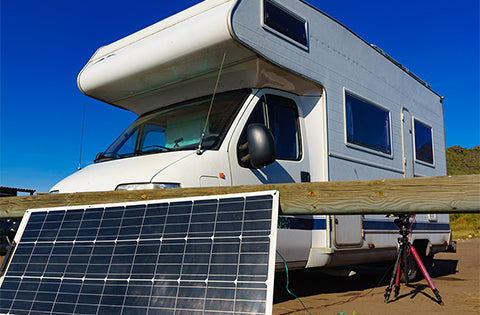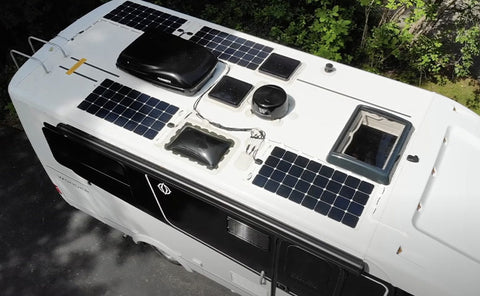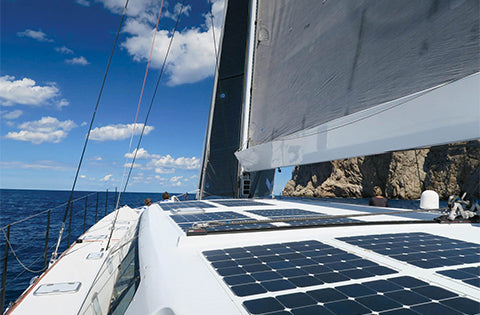If you’re one of the many campers who love to park your travel trailer in scenic off-grid spots, the length of your stay is often limited by the life of your RV’s batteries. With no shore power hookups in sight, you could use a generator to power up your rig, but even the quietest models will overwhelm the sounds of nature – and that defeats one of the big selling points of boondocking. So what’s an innovative RVer to do? It’s simple, go solar and let the sun be your RV’s battery charger!
The components you need for your RV
RV solar panels work just like the ones on your home. They soak up energy from the sun and create the power you need to run your off-grid life. There are three types of RV solar panels on the market today. With monocrystalline solar panels, each cell is a thin wafer of pure silicon crystal. These are the most efficient, and most expensive types of panels you can buy. Polycrystalline solar panels are slightly less efficient and slightly less expensive than monocrystalline, and each cell is made from melted and molded silicon. Amorphous panels are essentially a thin silicon film attached to a backing material that makes it flexible. These are the least expensive, and least efficient solar panels you can buy.
In addition to the panels, an RV solar setup needs a solar charge controller, an inverter, and a battery. The solar charge controller manages the energy generated by your solar panels so that you don’t overcharge your battery. Your RV solar system will also come with an inverter. The inverter’s job is to take the direct current (DC) generated by your solar panels and stored in your batteries and convert it into alternating current (AC). AC is what you need to power your RV’s outlets and most of the appliances.
The final component to your solar system is the battery bank, which stores all the energy your panels generate. There are four primary battery types found in RVs – flooded lead-acid, gel, absorbed glass mat (AGM), and lithium iron phosphate. We think lithium iron phosphate (LiFePO4) is the best for RV use in general, but also for RV solar systems. They’re fast charging and provide a lot more power than the other options.
RV solar panels: fixed or portable
If you’re buying a motorhome, fifth wheel, or a travel trailer that’s prepped for solar power, or comes with a solar system already installed, you’ll find that in most cases, the panels are located on the roof. Because they’re in a fixed location, you need your camper in just the right spot to be able to maximize the energy you can capture from the sun.
SOLARPARTS does solar in a different way. We don’t mount our panels on the roof but provide optional portable solar panels that connect quickly and easily into the pre-wired input on the side of your unit. We love the flexibility of the portable panels. First, they’re no bigger than a small suitcase and the foldable solar panels are easily stored in the closet. That means that if you’re going out for a week of camping with shore power, you can leave the solar panels at home. You can’t do that when they’re affixed to the roof!
With portable solar panels, you can park your panel in the shade, but position your panels in the best place on your campsite to get maximum solar exposure. This will keep your travel trailer naturally cooler because it’s not in the blazing sun, even though your panels are out soaking up the rays. If your panels are on the roof, you could wind up having to move your rig throughout the day to make sure your panels are positioned correctly. And that’s not what camping is all about!
Now that we have the basics of the RV solar panel kit down, let’s talk about how the whole thing works. First, you’ll lay out your portable solar panels, pointing them in the direction of the sun. Hook the wire from the panels up to the solar panel input, and you’re off and running. The wires from your panels take the energy you’re generating to the charge controller, then to the battery, then out to the inverter where it’s converted to AC power, and then ultimately to your outlets and appliances.
You will still need to be weather aware, though. Even with the SOLARPARTS solar panels, state of the art power management system, MPPT solar charge controller, inverter, and lithium iron batteries, you still need the sun to shine for your solar power system to work. And in the winter months, when the sun is lower in the sky, you’ll need to adjust how you position your panels to make sure you’re capturing the greatest amount of energy. When you add SOLARPARTS solar panels, you’ll have the ability to power everything you need. You’ll also have the best RV for a luxurious, and peaceful, boondocking experience.
Twitter: Solarparts Instagram: Solarparts
Tumblr: Solarparts Pinterest: Solarparts
Facebook: Shenzhen Solarparts Inc
Email address: Philip@isolarparts.com
Homepage: www.isolarparts.com





